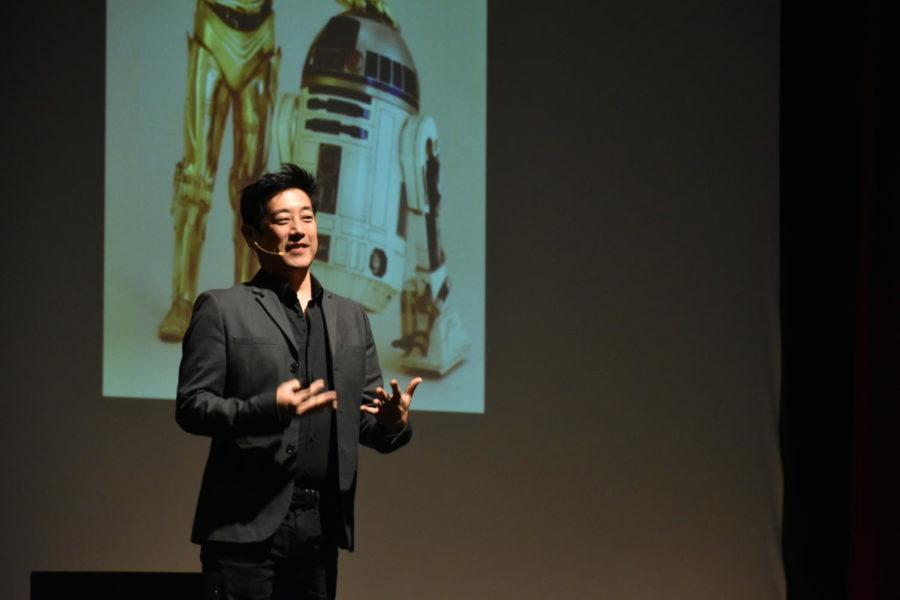Former Mythbuster Grant Imahara on Engineering for Entertainment
Grant Imahara shares stories from his careers in various industries at his lecture for Engineers’ Week on February 22, 2018.
February 21, 2018
Grant Imahara is most famously known for his work on the Discovery show “Mythbusters”. However, the earlier parts of his career were focused on working behind the camera rather than in front of it.
Imahara discussed both of these experiences in his lecture, “From Mythbusters to White Rabbit Project: Engineering Entertainment” Thursday night. He was the keynote speaker for the College of Engineering’s Engineer’s Week.
On “Mythbusters,” Imahara was a part of the “Build Team” along with costars Kari Byron and Tory Belleci.
The team was added in addition to lead hosts Adam Savage and Jamie Hyneman because of the unexpected length of time each episode took to create.
“They realized they didn’t have enough time to design, build and execute the myths on the schedule Discovery wanted,” Imahara said.
The show aimed to test and disprove social legends and urban myths, such as if drafting behind a big rig could improve car mileage or if a bird could knock a balancing a car tumbling over a cliff.
But before his myth-busting days, Imahara received a degree in electrical engineering from the University of Southern California. He then went on to work for Industrial Magic and Lights, a company founded by George Lucas.
Additionally, Imahara has a specialty in animatronics, which he describes as essentially “robots that mimic real creatures.”
Imahara worked on the animatronics for films such as Terminator 3: Rise of the Machines, A.I: Artificial Intelligence and Jurassic Park: Lost World.
He worked on other major blockbuster films as well, including Star Wars episodes one, two, and three.
Within the Star Wars universe, Imahara’s job was to take the fleet of R2D2’s on set and replace all the electronics inside them.
While actor Kenny Baker did play the onscreen R2D2, he only played him in the shots were the robot has two legs. For the scenes were they needed R2D2 doing something difficult for a human to do, such as speeding across a long distance, they made a second robot version. This difference can be noted in the films whenever R2D2 has three legs instead of two.
Those were not the only different versions of R2D2 made. There were multiple back-ups and other robots that went different speeds. Imahara’s job was to help all of these robots work and make sure they never ran out of energy in the middle of a shot.
Being a huge Star Wars fan growing up, it was almost surreal to Imahara that he was able to help work on R2D2.
“It was like all of my childhood dreams come true,” Imahara said. “It was a tremendous honor to be able to work on this iconic character.”
But his work for the Star Wars franchise didn’t end there. He revealed that Anthony Daniels, the actor who played C-3PO on screen, was not the only person to have been inside the robot’s legendary golden suit.
While Daniels was in London, Imahara got to play C-3PO at character appearances and events. He met a lot of celebrities, traveled all over the world to help with promotions, and even did car commercials Japan all while being behind the mask of C-3PO.
Other than Star Wars, Imahara helped construct and control the infamous Energizer bunny before it was done digitally.
While working on the bunny, one of the conditions his team had to meet was that the bunny had to be run on energizer batteries. He did meet that fact, and made the iconic energizer bunny run on 44 double-A batteries.
Another project Imahara discussed was the robotic skeleton, named Geoff Peterson, that he made for the old host of The Late Late Show Craig Ferguson. He created a co host robot, complete with a mohawk,for Ferguson in return for 100,000 followers on twitter.
At the end of his lecture, Imahara was asked what the hardest problem he’s ever had to solve as an engineer was.
Imahara responded that the hardest problem he’s had to solve was himself. He said that no matter what you’re building or creating, there is often this fear of failure that can even stop you from beginning a project in the first place.
“The most critical thing that I learned in my 10 years as a mythbuster was to overcome the fear of failure,” Imahara said.
Looking ahead, Imahara has been on the Build Team’s spin off Netflix show titled “The White Rabbit Project.” He is also currently working on new technology for Disney’s theme parks.
Even at where he is now, Imahara says that while testing and doing experiments at Disney, they fail all the time, but learn something each time from each failure.
“Failing early and failing often, that’s where you learn the most,” Imahara said.







